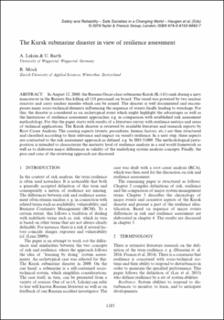Please use this identifier to cite or link to this item:
https://doi.org/10.21256/zhaw-2749| Publication type: | Conference paper |
| Type of review: | Open peer review |
| Title: | The Kursk submarine disaster in view of resilience assessment |
| Authors: | Leksin, Alexey Mock, Ralf Günter |
| DOI: | 10.21256/zhaw-2749 |
| Proceedings: | Safety and reliability : societies in a changing world |
| Page(s): | 1185 |
| Pages to: | 1192 |
| Conference details: | 28th European Safety and Reliability Conference (ESREL 2018), Trondheim, Norway, 17-21 June 2018 |
| Issue Date: | 2018 |
| Publisher / Ed. Institution: | Taylor & Francis |
| Publisher / Ed. Institution: | London |
| ISBN: | 978-0-8153-8682-7 |
| Language: | English |
| Subjects: | Resilienz; Risikoassessment |
| Subject (DDC): | 350: Public administration 363: Environmental and security problems |
| Abstract: | In August 12, 2000, the Russian Oscar-class submarine Kursk (K-141) sank during a navy manoeuvre in the Barents Sea killing all 118 personnel on board. The vessel was powered by two nuclear reactors and carry nuclear missiles which can be armed. The disaster is well documented and encompasses many socio-technical elements influencing the sequence of events finally leading to wreckage. For this, the disaster is considered as an archetypical event which might highlight the advantages as well as the limitations of resilience assessment approaches, e.g. in comparison with established risk assessment methodology. For this the paper starts with results of a literature survey with resilience metrics and areas of technical applications. The Kursk disaster is reviewed by available literature and research reports by Root Cause Analysis. The causing aspects (events, procedures, human factors, etc.) are then structured and classified according to their relevance and impact on vessel’s resilience. In a next step, these aspects are contrasted to the risk assessment approach as defined, e.g. by ISO 31000. The methodological juxtaposition is intended to characterize the maturity level of resilience analysis in a real world framework as well as to elaborate major differences in validity of the underlying system analysis concepts. Finally, the pros and cons of the reviewing approach are discussed. |
| URI: | https://digitalcollection.zhaw.ch/handle/11475/13185 |
| Fulltext version: | Published version |
| License (according to publishing contract): | CC BY-NC-ND 4.0: Attribution - Non commercial - No derivatives 4.0 International |
| Departement: | School of Engineering |
| Organisational Unit: | Institute of Sustainable Development (INE) |
| Appears in collections: | Publikationen School of Engineering |
Files in This Item:
| File | Description | Size | Format | |
|---|---|---|---|---|
| 2018_Leksin, Barth, Mock_Kursk submarine diaster_Safety and reliability.pdf | 1.7 MB | Adobe PDF |  View/Open |
Show full item record
Leksin, A., & Mock, R. G. (2018). The Kursk submarine disaster in view of resilience assessment [Conference paper]. Safety and Reliability : Societies in a Changing World, 1185–1192. https://doi.org/10.21256/zhaw-2749
Leksin, A. and Mock, R.G. (2018) ‘The Kursk submarine disaster in view of resilience assessment’, in Safety and reliability : societies in a changing world. London: Taylor & Francis, pp. 1185–1192. Available at: https://doi.org/10.21256/zhaw-2749.
A. Leksin and R. G. Mock, “The Kursk submarine disaster in view of resilience assessment,” in Safety and reliability : societies in a changing world, 2018, pp. 1185–1192. doi: 10.21256/zhaw-2749.
LEKSIN, Alexey und Ralf Günter MOCK, 2018. The Kursk submarine disaster in view of resilience assessment. In: Safety and reliability : societies in a changing world. Conference paper. London: Taylor & Francis. 2018. S. 1185–1192. ISBN 978-0-8153-8682-7
Leksin, Alexey, and Ralf Günter Mock. 2018. “The Kursk Submarine Disaster in View of Resilience Assessment.” Conference paper. In Safety and Reliability : Societies in a Changing World, 1185–92. London: Taylor & Francis. https://doi.org/10.21256/zhaw-2749.
Leksin, Alexey, and Ralf Günter Mock. “The Kursk Submarine Disaster in View of Resilience Assessment.” Safety and Reliability : Societies in a Changing World, Taylor & Francis, 2018, pp. 1185–92, https://doi.org/10.21256/zhaw-2749.
Items in DSpace are protected by copyright, with all rights reserved, unless otherwise indicated.